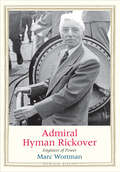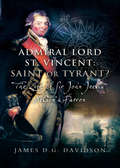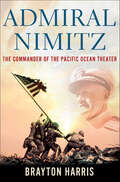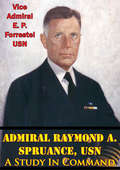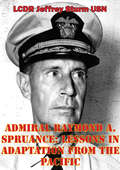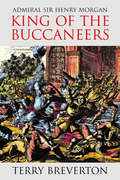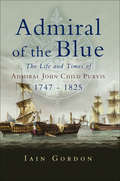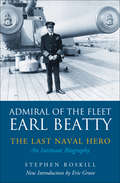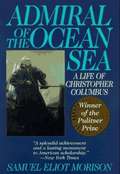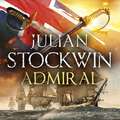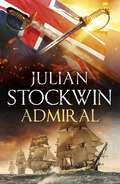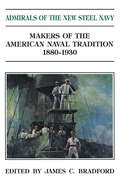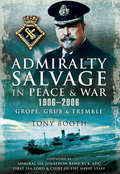- Table View
- List View
Admiral Hyman Rickover: Engineer of Power (Jewish Lives)
by Marc WortmanA riveting exploration of the brilliant, combative, and controversial &“Father of the Nuclear Navy&” &“Marc Wortman delivers a 17-gun salute to this short, profane spitfire who pulled a reluctant Navy into the atomic era. . . . Wortman opens a window into the life of an intellectual titan disdainful of nearly everything except scientific honesty, his adopted nation, and the power of the atom.&”—Jonathan W. Jordan, Wall Street Journal &“A superb and even-handed treatment of a complex, brilliant, and driven admiral who inspired both awe and loathing across the Navy he fundamentally reshaped.&”—Admiral James Stavridis, former Supreme Commander, NATO, and author of 2034 Known as the &“Father of the Nuclear Navy,&” Admiral Hyman George Rickover (1899–1986) remains an almost mythical figure in the United States Navy. A brilliant engineer with a ferocious will and combative personality, he oversaw the invention of the world&’s first practical nuclear power reactor. As important as the transition from sail to steam, his development of nuclear-propelled submarines and ships transformed naval power and Cold War strategy. They still influence world affairs today. His disdain for naval regulations, indifference to the chain of command, and harsh, insulting language earned him enemies in the navy, but his achievements won him powerful friends in Congress and the White House. A Jew born in a Polish shtetl, Rickover ultimately became the longest-serving U.S. military officer in history. In this exciting new biography, historian Marc Wortman explores the constant conflict Rickover faced and provoked, tracing how he revolutionized the navy and Cold War strategy.
Admiral Lord St. Vincent: The Life of Sir John Jervis, Nelson's Patron
by James D.G. DavidsonThis biography of John Jervis, who became Admiral Lord Vincent, makes compelling reading. It throws an oblique light on Nelsons personality. St Vincent, who was born twenty-three years before Nelson, and survived for eighteen years after Trafalgar, fundamentally influenced the younger mans career despite the two men being diametrically different characters. Yet without him, Nelsons genius might have been submerged by professional jealousy or emotional fragility.It was St Vincents strategy and preparation which positioned Nelson to win his three famous victories, but St Vincent himself made vital contributions not only to the defeat of Napoleon but to the well-being of the Royal Navy. Before he became First Lord of the Admiralty, the Navy had been severely weakened by corruption in the dockyards, nepotism in appointments and the appalling conditions under which the seamen lived and worked.St Vincent deserves the profound gratitude of the Nation; not only for enabling Nelson to exercise his tactical brilliance, but also for the role he played in preventing Napoleon from invading the British Isles.
Admiral Nicholas Horthy: Memoirs
by Admiral Nicholas HorthyAdmiral Nicholas Horthy was the Ruler of the Kingdom of Hungary during the interwar years and throughout most of World War II, serving from 1 Mar 1920 to 15 Oct. 1944...Horthy is remembered for, among other things, trying to surrender to the Russians when he realized that the war was lost. Hitler found out that Horthy through his son was negotiating a surrender to the Russians and had Horthy and his son arrested. On 15 Oct 1944, Horthy told his government ministers that Hungary had signed an armistice with the Soviet Union. "It is clear today that Germany has lost the war... Hungary has accordingly concluded a preliminary armistice with Russia, and will cease all hostilities against her." On that same day, 15 Oct. 1944, after Horthy had announced the armistice in a nationwide radio address, but which most of his troops did not hear, Hitler sent commando Otto Skorzeny to Budapest with instructions to remove Horthy from power. Horthy's son was meeting with Soviet representatives to finalize the surrender when Skorzeny and his troops forced their way into the meeting and kidnapped the younger Horthy at gunpoint. However, he did not kill them. Both Horthys got out after the war was over and the father lived long enough to write these memoirs. -Print ed.
Admiral Nimitz: The Commander of the Pacific Ocean Theater
by Brayton Harris“A superbly written biography” of the legendary Admiral who commanded the Allied Pacific Fleet during WWII (Carlo D’Este, author of Eisenhower and Patton).Chester Nimitz was an admiral’s Admiral, considered by many to be the greatest naval leader of the last century. After the attack on Pearl Harbor, Nimitz assembled the forces, selected the leaders, and—as commander of all US and Allied air, land, and sea forces in the Pacific Ocean—led the charge one island at a time, one battle at a time, toward victory.A brilliant strategist, Nimitz achieved remarkable victories against fantastic odds, outpacing more flamboyant luminaries like General Douglas MacArthur and Admiral “Bull” Halsey. And he was there to accept, on behalf of the United States, the surrender of the Japanese aboard the battleship USS Missouri in August 1945.In “meticulously researched, immensely informative, and laudably balanced” biography, Brayton Harris uses long-overlooked files and recently declassified documents to bring to life one of America’s greatest wartime heroes (Alan Axelrod, author of A Savage Empire).
Admiral Raymond A. Spruance, USN; A Study In Command
by Fleet Admiral C. W. Nimitz USN Vice Admiral E. P. Forrestel USN Rear Admiral E. M. Eller USNAlthough some historians and many newsmen have written many words about Admiral Raymond A. Spruance, U.S. Navy and his brilliant career in the Pacific in World War II, the complete story of this reserved and self-effacing man is now being told for the first time by one of his close friends and wartime associates. The author, Vice Admiral E. P. Forrestel, an important member of Spruance's Staff, was in an ideal position to observe and report on the thought processes of this great and successful naval officer. Spruance's rise to fame came in the Battle of Midway where his sound judgement and wise decisions won a stunning victory over greatly superior enemy forces. That victory reversed the long series of enemy successes and was truly the turning point in the war. From that time on he played an ever increasing part in our naval advance across the Pacific--a task he shared in full measure with another great American naval officer--Admiral W. F. Halsey, U.S. Navy. Tarawa, the Marshall Islands, the Marianas, Iwo Jima and the Ryukyus were important stepping stones along the way that lead to the deck of the U.S.S. MISSOURI in Tokyo Bay where the surrender terms were signed on September 2, 1945. To cap his extraordinarily successful naval career which ended in his Presidency of the Naval War College he accepted an appointment as our Ambassador in the Philippines. Here his wisdom and tact contributed importantly to the satisfactory settlement of a number of troublesome and vexatious problems that disturbed the good relations that should exist between the governments of the Philippines and the United States.It is given to few Americans to serve their country so effectively and at such high levels as did this man. His career will serve as an example and a challenge to service personnel and diplomats alike. His story will be read avidly by those who suffered his blows in war and by those who are hostile to our country.
Admiral Raymond A. Spruance: Lessons In Adaptation From The Pacific
by LCDR Jeffrey Sturm USNThe combination of fiscal constraints, expanding technology and globalization is causing the nature of warfare to rapidly evolve. The wars of tomorrow will not look like today's war. The ability to adapt to changing warfare environments hinges on a leader's ability to think broadly and view the operation through the lens of the entire conflict. This paper analyzes how Admiral Raymond A. Spruance prepared for the challenge of conducting amphibious assaults in the Central Pacific during World War II. Further, the paper uses Admiral Spruance's development as an operational thinker as a case study for today's leaders to prepare for the challenge of adapting to future operational environments. Admiral Spruance's operational education, operational training and experiential base is discussed and recommendations are provided to help today's leaders prepare for tomorrow's battles.
Admiral Sir Henry Morgan: King of the Buccaneers
by Terry BrevertonDiscover the truth about the 17th-century Welsh naval officer who became a hero for the British Empire—and not a bloodthirsty pirate.This is the swashbuckling biography of the naval officer known as the Sword of England, the Welshman Henry Morgan. Over the years, Morgan came to be portrayed as a black-hearted, fierce pirate. This error in terms and in the assessment of Morgan’s character led to the filing of the first libel lawsuit, brought in protest to a book published in 1684 claiming he had been an indentured servant, was a pirate, and was responsible for atrocities. In fact, Morgan was commissioned to aid the British navy in fighting enemies of the crown and was a superb military tactician who led a dozen victorious campaigns against massive odds.In 1655, Spain was the greatest naval and military power on earth, and controlled the sea lanes of Central America and the Caribbean. Henry Morgan’s career as a buccaneer officially began when, at age twenty, he landed in Barbados as part of a force deployed to capture Cuba or Hispaniola (Puerto Rico) for the British. The deployment failed, but the forces did capture Jamaica, which would become Morgan’s adopted home base for the rest of his life. From there, Morgan planned the attacks that would enrich the British throne and usher in the era of British supremacy on the high seas.For his leadership in battle and as lieutenant governor of Jamaica, Admiral Sir Henry Morgan deserves to take his place alongside Sir Francis Drake and the Duke of Wellington in the panoply of history’s greatest heroes.
Admiral Thunderbolt: The Spectacular Career of Peter Wessel, Norway’s Greatest Sea Hero
by Col. Hans Christian Adamson“A Sea Cadet in 1711 and a Vice Admiral in 1718, young Wessel barged into battle against his Swedish foes wherever he found them, often in direct violation of orders issued by timid souls in the Admiralty. But Frederik IV, King of Denmark-Norway, loved a winner. He gave his youthful fighting cock promotion after promotion, over scores of officers of senior vintage. The result was that Peter had almost as many enemies among officers in the Danish-Norwegian Navy as he had in that of Sweden.“So great were his battle conquests and his services to the nation that Captain Wessel, soon after his twenty-fifth birthday, was given a Patent of Nobility and the name Tordenskjold. Roughly translated, this means (Torden) The Thunderbolt that Strikes and (Skjold) The Shield that Defends. In actions on land and sea, Tordenskjold lifted his nom de guerre to deathless and stratospheric heights.“While this book is based on historical events and peopled by real persons, it is by no means a definitive history. The Great Northern War, which ran from 1709 to 1719, sucked Denmark-Norway, Russia, Poland, and England into conflict against the then mighty Sweden. Its pattern is too complicated for compression into a one-volume book dedicated to pinpointing the career of a single participant. For that matter, the historical facts, folklore, and legends that have been built up over the centuries around Vice Admiral Peter Tordenskjold are so voluminous that, in themselves, they could cover quite a spread of bookshelf! The problem has not been what to put into this book, but what to leave out and still do justice to its subject.”
Admiral William A. Moffett
by William F. TrimbleNaval aviation historian William F. Trimble provides a clear and detailed portrait of the man who took on the challenge of forming an aeronautical bureau within the U.S. Navy in 1921 and then nurtured the early development of naval aviation. Describing Admiral William A. Moffett as one of the first high-ranking naval officers to appreciate the importance of the airplane and the effect it would have on the fleet, the author contends that the admiral's strong background as a surface officer gave him a credibility and trust with his superiors that others could not match. The author attributes Moffett's desire to keep aviation as part of the fleet, along with his diplomacy, tenacity, and political and military savvy, to the success of the infant air arm during its formative years. In striking contrast to the tactics of Army General Billy Mitchell, Moffett's handling of the loyalty issue and other politically sensitive topics saved the Navy's air arm, according to Trimble. The book is equally candid about the admiral's shortcomings, including his heavy-handed support for airships, a technological dead end that squandered millions and led to Moffett's death in 1933 when he went down with the airship Akron during a storm.
Admiral of the Blue: The Life and Times of Admiral John Child Purvis (1747–1825)
by Iain GordonAdmiral John Child Purvis was a contemporary naval officer of Nelson, who never disobeyed an order and did his job well. His ability as a fighting commander was proved in a bloody duel between his sloop-of-war and a French corvette during the War of American Independence. As a battleship Captain, he was the first British officer to confront Napoleon Bonaparte, muzzle to muzzle, during the Siege of Toulon. Commanding the Princess Royal and then the London, he was involved in much action in the Mediterranean and served under the legendary Sir John Jervis (later Lord St. Vincent).Later, as a Flag Officer, he rejoined the Mediterranean Fleet first as second-in-command and then as Commander-in-Chief. The culmination of his long and distinguished career at sea was saving the Spanish fleet in Cadiz from capture by the French and preparing the city for siege.
Admiral of the Fleet Earl Beatty: An Intimate Biography
by Stephen RoskillAdmiral Beatty was beyond doubt the best known fighting Admiral, perhaps the best known military leader, of the First World War. His conduct at Heligoland Bight and Dogger Bank, and later at Jutland, caught the public imagination, while his role as Commander-in-Chief of the Grand Fleet in taking into custody the German High Sea Fleet in November 1918 associated him with perhaps the most tangible symbol of the collapse of Germanys military might. He is probably remembered by most for his comment at Jutland that there seems to be something wrong with our bloody ships today after two of his battlecruisers were sunk in quick succession.Stephen Roskills magnificent biography of Beatty explains so well why he has come to be seen as Britains last naval hero, an admiral in the mould of Nelson who won the unstinting devotion of all those who served with and under him. He came from an Anglo-Irish military family who exhibited the utmost gallantry on the field of battle with a corresponding recklessness in the hunting field, while he himself was extremely handsome and courageous and exuded charisma. His early promise led to fast promotion and he was to become the youngest Admiral since Nelson.But that is only one part of the story and there are aspects of his character that were not entirely admirable. There were, and still remain, questions over his handling of the 1st Battlecruiser Squadron at Jutland at which his highly aggressive approach was contrasted with the prudence of his commander, Sir John Jellicoe, and the later animosities between the Jellicoe and Beatty camps reflect poorly on Beatty himself. His turbulent marriage and his extra-marital liaisons were to be suppressed in his official biography but in some ways these aspects are as significant to our understanding of him as Nelson and Emma Hamiltons great affair is to our reading of the Napoleonic era at sea.Roskill deals with all these issues and in doing so brilliantly reassesses Beatty place in history. Access to new material at the time of writing allowed him to write a balanced and wholly credible account of an extraordinary life, and this wonderfully readable and intimate biography will appeal to a whole new generation of readers.
Admiral of the Ocean Sea: A Life of Christopher Columbus
by Samuel Eliot MorisonAdmiral of the Ocean Sea is Admiral Samuel Eliot Morison's classic biography of the greatest sailor of them all, Christopher Columbus. It is written with the insight, energy, and authority that only someone who had himself sailed in Columbus' path to the New World could muster. Morison undertook this expedition in a 147-foot schooner and a 47-foot ketch, the dimensions of these craft roughly matching those of Columbus' Santa Maria and Niña. The result is this vivid and definitive biography that accurately details the voyages that, for better or worse, changed the world.<P><P> Pulitzer Prize Winner
Admiral: Thomas Kydd 27 (Thomas Kydd #53)
by Julian StockwinApril 1814. Napoleon is deposed and exiled after defeat by a resurgent allied collation. Saddled with huge war debts, the British government has no choice but to place many of its naval ships in reserve. Captain Sir Thomas Kydd is one of the lucky officers not to be put on half pay. Instead, in the realisation of his life's ambition, he is offered an admiral's flag, but the station is West Africa and with it comes anti-slavery operations set in fever-ridden swamps. Despite the obvious dangers and hardships, Kydd readies for sea with his beloved Thunderer as his flagship. But before he can set sail comes the electrifying news - the tyrant has escaped from Elba and is marching on Paris, the citizens flocking to join him. Napoleon's invasion fleet is still in being and if the French navy declares for him they can sail from the ports now free of blockade and make the invasion of England a reality. What's more, the entire Channel Fleet has been stood down, its ships in various stages of repair. There's one man in active service who happens to be on the spot - Admiral Sir Thomas Kydd. With frantic haste he's appointed temporary commander-in-chief to sail with all the men-o'-war that can be scraped together to stand athwart the French. Waterloo is coming but before then Kydd must use all his legendary subterfuge and daring to save England from her peril. Admiral is the twenty seventh and last of the adventures of Captain Sir Thomas Kydd whose story began in the year 1793 and tells for the first time in fiction how a pressed man through his bravery and ingenuity progresses to the quarterdeck of his own ship, and here, in the final book of the series, the command of a fleet with an admiral's pennant.
Admiral: Thomas Kydd 8 (Thomas Kydd #53)
by Julian StockwinApril 1814. Napoleon is deposed and exiled after defeat by a resurgent allied collation. Saddled with huge war debts, the British government has no choice but to place many of its naval ships in reserve. Captain Sir Thomas Kydd is one of the lucky officers not to be put on half pay. Instead, in the realisation of his life's ambition, he is offered an admiral's flag, but the station is West Africa and with it comes anti-slavery operations set in fever-ridden swamps. Despite the obvious dangers and hardships, Kydd readies for sea with his beloved Thunderer as his flagship. But before he can set sail comes the electrifying news - the tyrant has escaped from Elba and is marching on Paris, the citizens flocking to join him. Napoleon's invasion fleet is still in being and if the French navy declares for him they can sail from the ports now free of blockade and make the invasion of England a reality. What's more, the entire Channel Fleet has been stood down, its ships in various stages of repair. There's one man in active service who happens to be on the spot - Admiral Sir Thomas Kydd. With frantic haste he's appointed temporary commander-in-chief to sail with all the men-o'-war that can be scraped together to stand athwart the French. Waterloo is coming but before then Kydd must use all his legendary subterfuge and daring to save England from her peril. Admiral is the twenty seventh and last of the adventures of Captain Sir Thomas Kydd whose story began in the year 1793 and tells for the first time in fiction how a pressed man through his bravery and ingenuity progresses to the quarterdeck of his own ship, and here, in the final book of the series, the command of a fleet with an admiral's pennant.
Admiral: Thomas Kydd 8 (Thomas Kydd #53)
by Julian StockwinApril 1814. Napoleon is deposed and exiled after defeat by a resurgent allied collation. Saddled with huge war debts, the British government has no choice but to place many of its naval ships in reserve. Captain Sir Thomas Kydd is one of the lucky officers not to be put on half pay. Instead, in the realisation of his life's ambition, he is offered an admiral's flag, but the station is West Africa and with it comes anti-slavery operations set in fever-ridden swamps. Despite the obvious dangers and hardships, Kydd readies for sea with his beloved Thunderer as his flagship. But before he can set sail comes the electrifying news - the tyrant has escaped from Elba and is marching on Paris, the citizens flocking to join him. Napoleon's invasion fleet is still in being and if the French navy declares for him they can sail from the ports now free of blockade and make the invasion of England a reality. What's more, the entire Channel Fleet has been stood down, its ships in various stages of repair. There's one man in active service who happens to be on the spot - Admiral Sir Thomas Kydd. With frantic haste he's appointed temporary commander-in-chief to sail with all the men-o'-war that can be scraped together to stand athwart the French. Waterloo is coming but before then Kydd must use all his legendary subterfuge and daring to save England from her peril. Admiral is the twenty seventh and last of the adventures of Captain Sir Thomas Kydd whose story began in the year 1793 and tells for the first time in fiction how a pressed man through his bravery and ingenuity progresses to the quarterdeck of his own ship, and here, in the final book of the series, the command of a fleet with an admiral's pennant.
Admirals of the New Steel Navy
by James C. BradfordThis collection of essays examines the lives of thirteen naval officers whose careers had lasting effects on the evolution of American naval traditions.
Admiralty Salvage in Peace and War 1906–2006: Grope, Grub and Tremble
by Tony BoothHistorian Tony Booth presents a fascinating history of British naval salvage over the course of a century during war and peacetime.The importance of marine salvage during armed conflict has been vastly underestimated since becoming a vital Naval arm during the First World War. Between 1915 and 1918 the Admiralty Salvage Section saved nearly 400 merchant vessels, desperately needed to bring food and war materials into Britain. During the Second World War, some two million tons of shipping was successfully recovered. From D-Day onwards Admiralty salvage men cleared many stricken craft from the Normandy beaches alone, often under heavy shellfire. Then, as the Germans retreated back across Europe, salvage teams undertook vital port clearance duties. During the Suez Crisis, Falklands Conflict and even the Gulf War the same story can be told. And their peacetime operations have also been important. Drawing on a wealth of official documents, Admiralty Salvage in Peace and War 1906-2006 is the first book to explore in depth the courage, personal sacrifice and invaluable contribution these forgotten heroes have made during both peace and war.
Admonition
by Chris ThrosbyBorn in the late 1700s, Admonition's mother has already made her believe her name carries a curse. When her home - along with most of her family - is swallowed by a sink hole, she is taken in by neighbours who provide her with a loving home. She is only 13 when things start to change. By the time she reaches 15, the curse is confirmed, when she is forced to leave by the sexual advances of the man who had initially taken her - a confirmation that is repeated many times in her life. Finding a home with Jabez, the landlord of The Boar's Head, she becomes embroiled in salt smuggling that leads ultimately to transportation and a new life in Australia where she finally finds true love and freedom. As Admonition says at the end of her story, 'Now, I wish there was a way I could tell her what's taken me a lifetime, not to mention a journey to the other side of the world, to learn: we can be unlucky, unfortunate, even oppressed by our circumstances or by those around us, but we are never affected by curses and certainly not by our name - unless of course we choose to believe it.'
Admonitions on Governing the People: Manual for All Administrators
by Yagyong ChongThis is the first English translation of one of Korea’s most celebrated historical works, a pre-modern classic so well known to Koreans that it has inspired contemporary literature and television. Written in 1821 by Chong Yagyong (Tasan), Admonitions on Governing the People (Mongmin simso) is a detailed manual for district magistrates on how to govern better. In encyclopedic fashion, Chong Yagyong addresses the administration, social and economic life, criminal justice, the military, and the Confucian ritual system. He provides examples of past corrupt officials and discusses topics of the day such as famine relief and social welfare. A general call for overhauling the Korean ruling system, the book also makes the radical proposition that the purpose of government is to serve the interests of the people. This long-awaited translation opens a new window on early-nineteenth century Korea and makes available to a wide audience a work whose main concerns simultaneously transcend national and cultural boundaries.
Adobe Days
by Sarah Bixby SmithIn this rollicking reminiscence Sarah Bixby Smith tells of Los Angeles when it was "a little frontier town" and "Bunker Hill Avenue was the end of the settlement, a row of scattered houses along the ridge." She came there in 1878 at the age of seven from the San Justo Rancho in Monterey County. Sarah recalls daily life in town and at San Justo and neighboring ranches in the bygone era of the adobes. Exerting a strong pull on her imagination, as it will on the reader's, is the story of how her family drove sheep and cattle from Illinois to the Pacific Coast in the 1850s. The daughter of a pioneering woolgrower, Sarah Bixby Smith became a leading citizen of California.
Adobe Days: Being The Truthful Narrative Of The Events In The Life Of A California Girl On A Sheep Ranch (large Print Edition)
by Sarah Bixby Smith"In this rollicking reminiscence Sarah Bixby Smith tells of Los Angeles when it was "a little frontier town" and "Bunker Hill Avenue was the end of the settlement, a row of scattered houses along the ridge." She came there in 1878 at the age of seven from the San Justo Rancho in Monterey County. Sarah recalls daily life in town and at San Justo and neighboring ranches in the bygone era of the adobes. Exerting a strong pull on her imagination, as it will on the reader's, is the story of how her family drove sheep and cattle from Illinois to the Pacific Coast in the 1850s. The daughter of a pioneering woolgrower, Sarah Bixby Smith became a leading citizen of California."-Print ed.
Adobe Doorways
by Dorothy L. PillsburyFollowing on from the first in this series, No High Adobe, which was published in 1950, in this 1952 follow-up, Adobe Doorways, author Dorothy L. Pillsbury takes the reader on a journey into the heart—and often the soul—of Northern New Mexico. We visit Teronrio Flat, as well as friends in the Indian Pueblos and Spanish-American villages in the mountains.As with No High Adobe, this exuberant collection of thirty-six tales emanate from the author’s deep experience of the land and its people, conveying the spirit of both with the care of a loving friends and the skill of a talented storyteller.
Adobe Palace: The Kincaid Family Series - Book Four (The Kincaid Family Series #4)
by Joyce BrandonThis “unforgettable Western epic” from the author of Lady and the Lawman is “a superb achievement as both a saga and a romance” (RT Book review, 4 Stars). Arizona Territory, 1889. After her parents died at sea, little Samantha Forrester came to live with the Kincaid family . . . and strapping young Lance Kincaid became her adored protector. Years later, when Lance married another woman, Samantha tried to forget him by marrying his friend Jared. But Jared wasn’t Lance. When he died, he left Samantha a single mother, still heartsick for another woman’s husband. Then the devilishly charming Steve Sheridan rides into Samantha’s life. Suddenly she sees her chance to build the house of her dreams, save her son’s life, and claim Lance’s heart for her own. But life doesn’t always go according to plan, and fate will take them all on a journey as wild as the land they live on.
